I am by nature a solo kayaker and seize the chance to go paddling when time and weather allow. While I’d enjoy the company and help of a paddling buddy, lining one up doesn’t seem to work with my spur-of-the-moment planning and will-of-the-wisp exploring.
As a 69-year-old lake lover with spinal alignment issues, I’d been able just to manage loading my 12′, 42-lb rotomolded kayak on my 2004 Subaru Impreza by myself. I’d prop the bow on a folding sawhorse, lay a rag rug over the hatchback window, then shove the kayak up onto the upright J-carriers on my roof racks. I’d done this for quite a few years, and it worked well.
This spring, it was time to replace my dear Impreza, but the newer ones were too low-slung so I bought an Outback. It has the clearance I need for the semi-remote gravel roads I travel, but it’s slightly taller than my old Impreza. The extra height and the spoiler would make loading more challenging. I bought a suction-cup-mounted kayak roller to get me “over the hump” but, worried the struggle would send me to the chiropractor, never tried it. I enjoyed paddling the chain of lakes where my husband and I have a rustic camp, but it was a frustrating summer not having an easy way to go kayaking elsewhere.
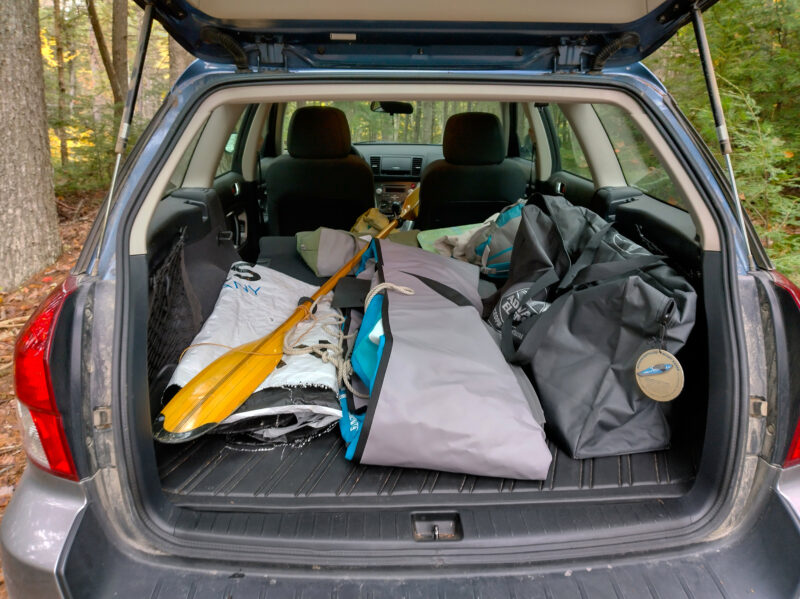 Photographs by the author and Richard Washburn
Photographs by the author and Richard WashburnFolded in half lengthwise and then in thirds horizontally, the kayak easily fits into the trunk of the author’s Outback along with a heavy-duty plastic sheet on which to drag the kayak from the car to the launch, a 230-cm one-piece Malone feathering paddle, a life jacket and miscellaneous gear, and the kayak’s duffel bag, which holds the seat, pump, and other accessories.
In late September my dad sent me a link to an online review of inflatable kayaks, with the suggestion, “When cartopping gets to be too much of a chore, maybe this would work?” Two days later I had a serendipitous encounter with a kayaker bringing his inflatable ashore at a nearby lake. His enjoyment of his boat and the freedom it allowed him with its easy transport and setup inspired me to look it up online. It was well rated, but he’d admitted it wasn’t great in waves, so I shopped further and found a few other candidates in my size and price range. I kept coming back to the sweetly designed 10′ 6″ AdvancedFrame Sport Special Edition from Advanced Elements. With its semi-enclosed cockpit, moderate 32″ beam, and enthusiastic reviews, it seemed a kayak I’d feel comfortable and safe in. The reviews promised a paddling experience more like a hard-shell kayak than other inflatables, with better tracking and handling in waves due to the internal aluminum ribs and deck inserts that sharpen and define the bow and stern. At 26 lbs, it would be a bit heavier than other inflatables I had my eye on, but it seemed important to choose a boat I’d enjoy paddling, which, as my husband, Richard, told me, “is the whole point.” I ordered an Advanced Elements AdvancedFrame Sport Special Edition from an outdoor equipment retailer.
Before setting off on my first sea trials at a local pond, I asked Richard to help me set the kayak up on the lawn at home, to get the hang of inflating and deflating it. The kayak came fully assembled from the factory, neatly folded in a waterproof duffel bag with an owner’s manual, adjustable folding seat, repair kit, double-action pump with built-in pressure gauge, and other accessories.
After spreading it out and identifying all the parts, despite all the clear directions and diagrams about the spring and twist valves and proper inflation of the boat’s four chambers, it took us an hour to figure out how the pump worked with its various adapter tips and inflation/deflation ports. The pump came with four different adapters attached on a plastic loop tie to prevent losing them. Good idea, but confusing and in the way when I’d only be using the two adapters that fit my boat’s valves. We cut the cord and tied just the two tips I’d be using back on.
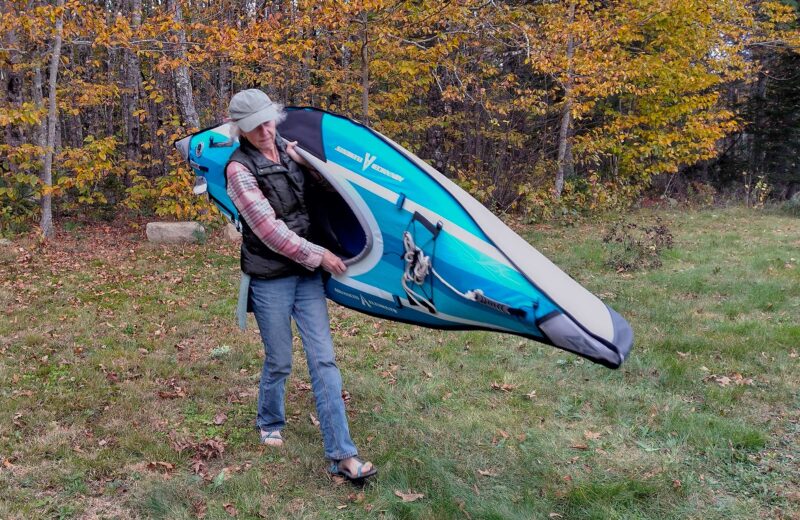
In comparison to other inflatable kayaks, the AdvancedFrame Sport is somewhere between ultralight and heavy. Although it can be carried folded into thirds and fourths, it is an easier lift if the kayak is inflated and then rested on the bearer’s shoulder. In that position it is well balanced and easily handled.
The kayak’s air chambers are inflated in a particular order while watching the pump’s gauge carefully to avoid exceeding the recommended pressure for each. There’s a learning curve to the valves and pumping process, but having inflated the kayak a few times, I now find it’s a snap and takes only 5 to 10 minutes to pump up the four air chambers. With both feet on the pump’s foot flanges, and both hands on the handles, I watch the pressure gauge as I pump, and slow down as the needle nears the right pressure. Clip in the seat, and I’m good to go.
A caveat in the manual is to be mindful of water and air temperature, as on a cold day the chambers may lose pressure and the kayak may sag, while “in hot weather or prolonged sunlight, the air inside it will expand. You must let some air out of the appropriate chambers to prevent the kayak from failing due to overpressure.” It wasn’t a concern during my October trials, but the warning is one I’ll take seriously in the summer.
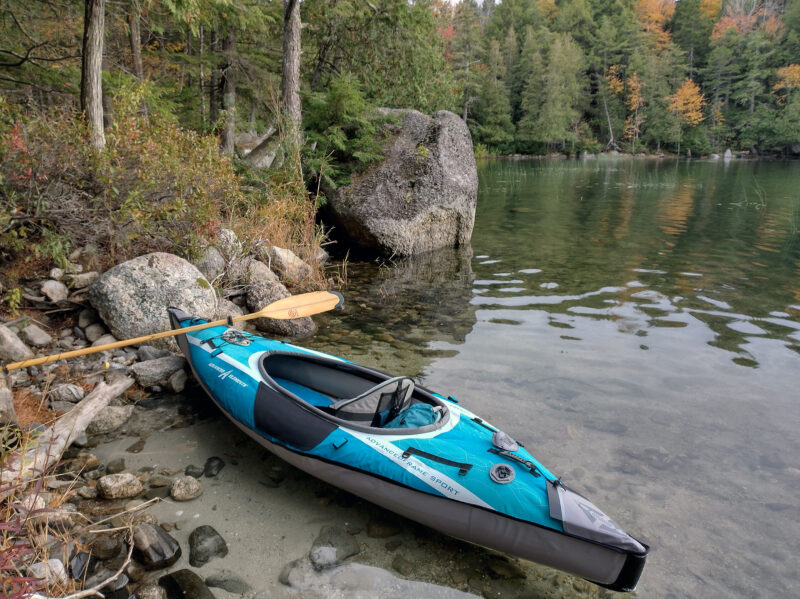
The beauty of any kayak is being able to paddle through the shallows and pull up onto a sheltered beach away from the crowds. Despite being an inflatable, the tough three-layered skin of the AdvancedFrame Sport is rugged enough to be pulled (gently) ashore.
The hull is made of three layers of PVC tarpaulin material (polyester fabric with vinyl bonded on both sides) for puncture resistance, with reinforcing material covering the welded hull-to-deck and bow and stern seams. Both for safety and longevity, I’m careful how I launch and land, to protect the bottom from abrasion. When getting in and out, I wade the kayak into the shallows, bracing my hands forward on the sturdy cockpit coaming to hold my weight as I step one foot in the center of the floor. (The 32″ beam is too wide for me to straddle for a seat-first entry.) Then, with my hands bracing behind, I bring my other leg in as I sit down.
The accommodations are amazingly comfortable, with a nicely made, cushioned, buckle-in folding seat with high backrest. The trick is sitting down in the center of the seat, in front of the hinge, with the backrest nearly vertical, for the most comfortable position. Once I’m in, I can adjust the backrest angle with the straps, but it’s hard to shift the seat base back and forth with my weight on it. If I get in and the seat position doesn’t seem quite right, I try again until I find the sweet spot. Once I’m seated comfortably with the backrest upright, it’s a great seat and I can paddle quite a ways before wanting to come ashore and stretch my legs.
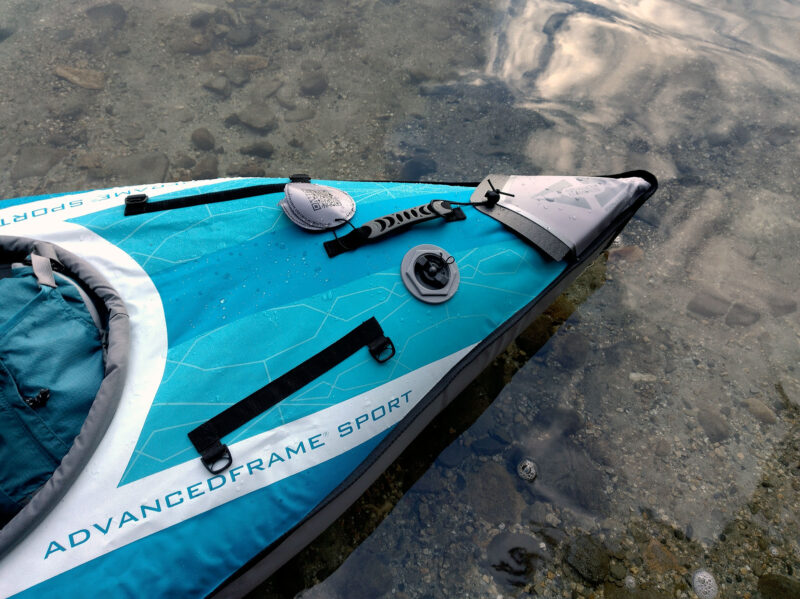
There is a cargo area behind the seat and a small amount of storage under the aft deck. Elsewhere, D-rings (as seen here on the aft deck) and bungees (on the foredeck), offer a variety of options for carrying gear. At both the bow and stern, reinforced nylon-strap handles can be used to lift the ends of the boat or for carrying by two people.
The seatback has a sewn-in mesh pocket, which came with a repair kit tucked inside. I carry a sponge in the pocket to mop up any puddles from drips or rain if caught in a shower. I also carry an oval piece of blue sleeping-pad foam to protect the inflatable floor from getting scuffed by sand and grit as I step in and out of the boat.
The cockpit is perfectly sized for easy entry and comfortable paddling, with just the right leg room. There are no foot braces, but I can easily adjust the seat straps so I can rest my feet against the air chambers in front if I want that sense of support I’m used to in my hard kayaks. I’m finding the trim feels better, though, if I adjust the straps to put me an inch or two farther aft. This still leaves plenty of storage space in the cargo area aft of the seat.
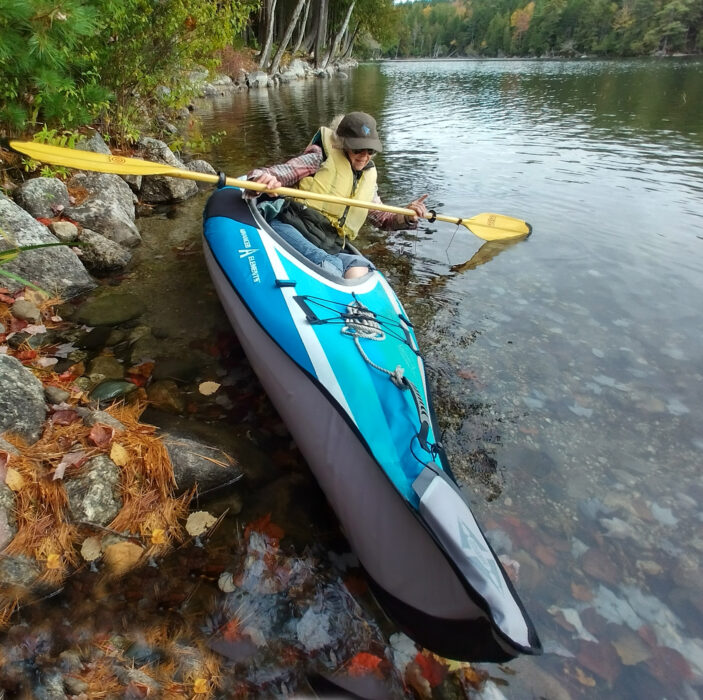
The AdvancedFrame Sport kayak is remarkably stable. The author was surprised by how far she could lean over while still feeling on the “safe side of capsizing.”
I find the kayak reassuringly stable, both in its initial stability when I’m getting in and out of the cockpit and in its secondary stability when I lean to the side. I was amazed how far I could lean over without tipping, the water just grazing the hull-to-deck seam. That boosted my confidence in the boat’s safety. The Sport’s 32″ beam seems just right—wide enough for stability plus a good width for the 230 cm feathering double-bladed paddles I already have for my other kayaks, and indeed, they are perfect for this boat, which is a little beamier but shallower.
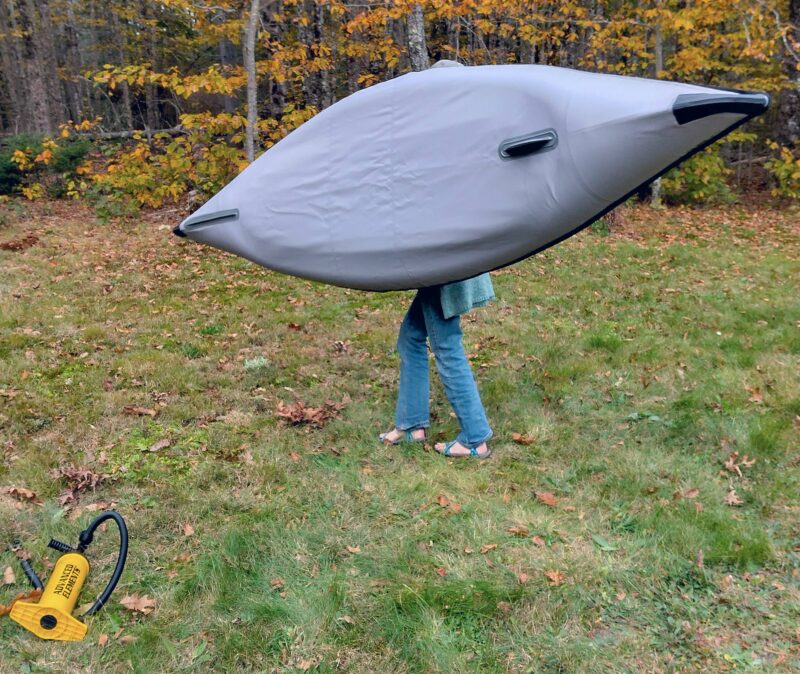
A molded skeg is attached to the stern (at right) to aid tracking and another attachment at the bow has a lower profile and protects the hull when coming ashore.
The Sport is a pleasure to paddle. Properly inflated, it tracks remarkably well for a 10′ 6″ boat, with the frame in the bow providing a sharp entry and a skeg fused on the bottom aft. I find the bow yaws 2″ to 3″ with each stroke, but not annoyingly so. I had thought I might have to buy the optional “backbone” (a tubular keelson) or drop-stitched floor to stiffen the hull, as recommended by some reviewers, but for my weight (120 lbs in a hull of 250 lbs total capacity) it seems to handle just fine with only the built-in floor (twist-valve chamber #2), inflated to the recommended 1 psi. It cruises along quite well, almost as fast as my 12′ rigid kayaks. I’m strictly a flatwater paddler, and prefer poking along protected lake and pond shores, exploring sandy-bottomed coves, admiring the vintage camps, scenery, and geologic features, and botanizing. Sometimes I’ll cut across open water in light wind and waves, and the little blue inflatable has handled well so far in those conditions.
I’ve been impressed with how well the kayak is designed and made. Its shapely, attractive lines are accented by the curved gray-fabric coaming and black-fabric edging along the seams. Advanced Elements shines as an innovator in inflatable construction, with its well-thought-out performance-first design, quality materials, sturdy construction, and valve system, and all the thoughtful touches and accessories that make the Sport a stylish, safe, user-friendly boat. It includes all the features I enjoy on my hard-shell kayaks—rugged bow and stern handholds, bungee deck rigging—plus neoprene paddle guards, Velcro paddle holders, and ample cargo space. The only thing missing is a watertight hatch, but a small drybag could be stowed under the aft deck.
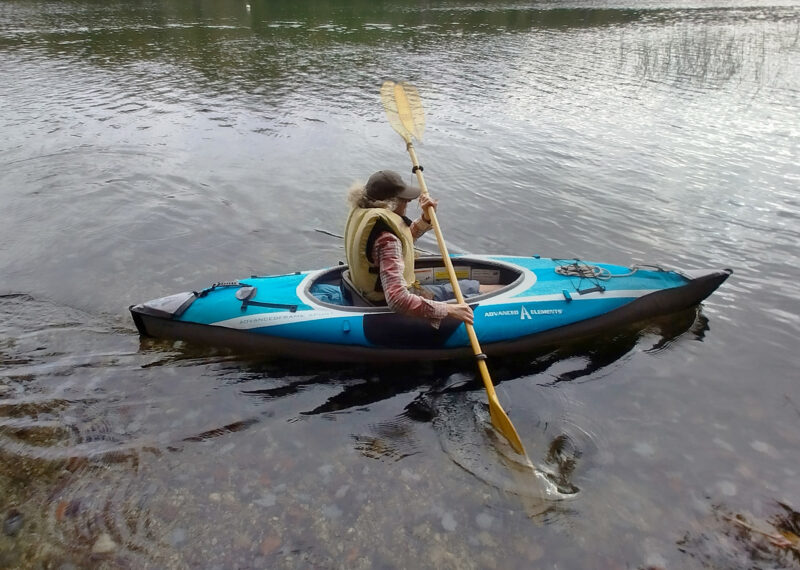
The AdvancedFrame Sport kayak has a semi-enclosed cockpit with enough room for easy entry but surrounded by reassuringly wide side decks. Unlike many inflatable kayaks that have shallower cockpits and raised seats, here the generous depth of the cockpit, with its cushioned seat resting on the inflatable floor, helps to keep the kayak stable when getting in and out and when paddling in breezy conditions.
Best of all is the Sport’s ease of transport and carrying. I can most comfortably carry the kayak when it’s firmly inflated, with the cushioned coaming resting on my shoulder. Even though the kayak weighs only 26 lbs, when deflated and folded it’s a little more unwieldy, but I’m getting adept at grasping and lifting it in the middle, folded first in half lengthwise, then in thirds, with the bow and stern overlapping in the middle. This makes a manageable bundle about 48″ long by 18″ wide by 8″ thick, which fits nicely in the back of my car.
To fit in the duffel bag, the manual recommends using the pump to fully deflate the air chambers, then folding the kayak in half lengthwise and quartering horizontally into a neat package 30″ long by 17″ wide by 14″ thick. It also emphasizes the importance of drying the kayak thoroughly before folding for extended storage.
I’m delighted with my AdvancedFrame Sport Kayak and being free to follow my watery whims without the stress of cartopping. I consider it a great value and look forward to a new world of paddling adventures next season.![]()
Jane Crosen lives in Penobscot, Maine, where she publishes her hand-drawn maps and other map products as Jane Crosen, Mapmaker. She writes and copy-edits books and publications including this magazine. This is her first article for Small Boats.
The AdvancedFrame Sport Kayak and manual are available direct from Advanced Elements for $549.99. The company has a wide network of retailers.
Is there a boat you’d like to know more about? Have you built one that you think other Small Boats readers would enjoy? Please email us!
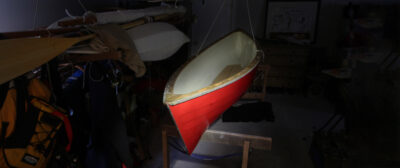
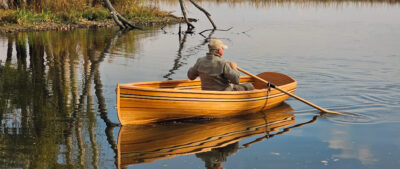
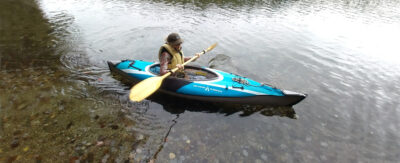
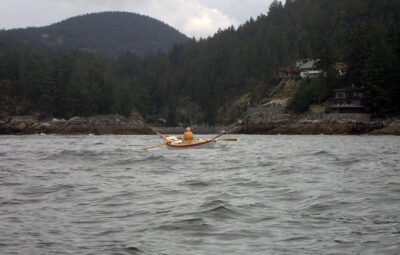
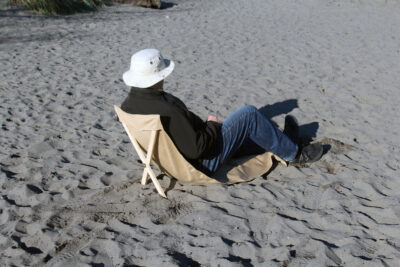
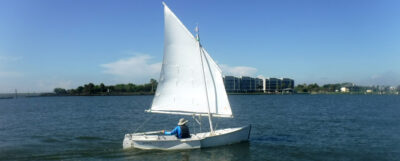
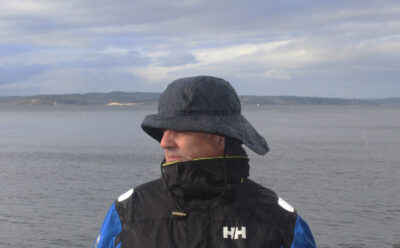
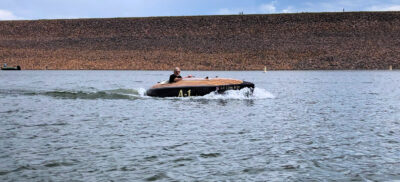
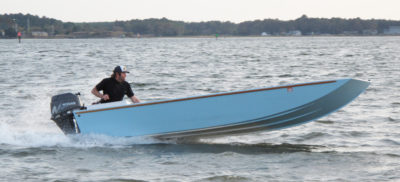

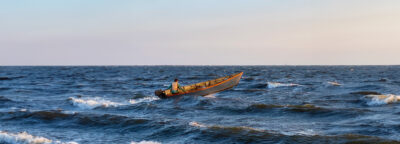
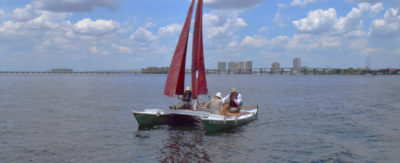
Thanks for the review. Sounds like a good fit for your situation.
Speaking of fit, any idea on how tall a person that boat might accommodate? That is, how much additional leg room do you have?
I looked at their web site and don’t find any dimensions that would indicate just how much leg-length room there is.
I’ve owned one of these for several years. I’ve been pleased with the overall performance and comfort. I’ve snagged the bottom on a few barnacles from time to time, but only had minor damage.
I bought mine because of the quality of design and construction was the best at the time and because I needed an auxiliary craft for getting ashore that didn’t have to be towed or stored on deck. Since I’ve downsized my boat ownership further, we’ve found that they’re great for stowing in the back of our valiant little Honda and hitting a stream/lake/bay almost anywhere. We often take them along “just in case.”